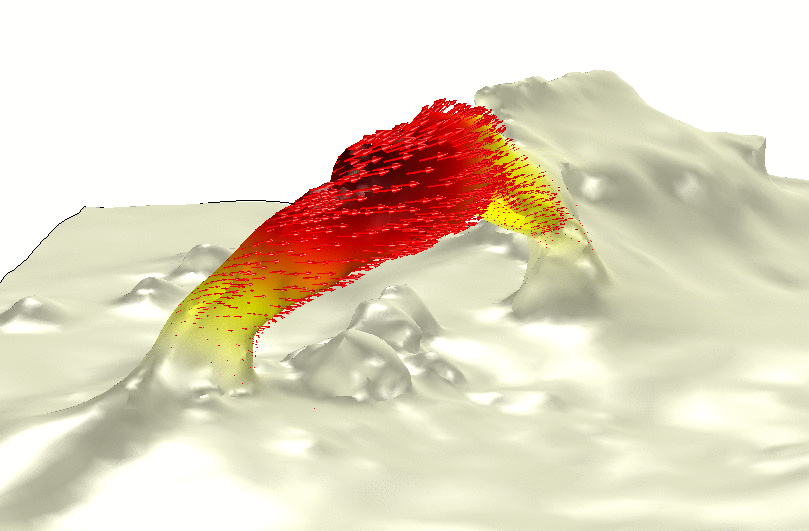

By Zoe Woodcraft
The sound is like a low, steady rumble, soothing yet powerful. Imperceptible to the human ear, the hums of red rock arches in Bears Ears and Grand Staircase National Monuments carry with them the deep patterns of the earth’s plates sparked by events like ocean currents colliding in the open Pacific that pump the ocean floor. On the surface, wind spilling over the arches amplifies the vibrations, giving voice to movements in the earth that began thousands of miles away.
Scientists like Jeff Moore have only recently discovered the arches’ hum. We are one year into the legal battle to defend Bears Ears and Grand Staircase, and while we fight in the courts, life and discovery continue in these special places. Now, more than ever, the arches need our voices to protect them.
Moore, a professor at the University of Utah, has always been fascinated by what makes rocks break and move. That’s how he describes his particular niche in geology, geohazards.
“The earth is teeming with these sorts of mysteries, and it’s my job to uncover them,” said Moore.
Hardy sandstone gives Utah its famous rock formations. Its layers can split open like an accordion and gently erode over millennia into shapes nearly impossible in earthquake country. Moore began to log the swelling and contracting of Utah’s arches as temperatures rose and fell during the day. He wanted to understand their stresses, and know how long their spans will extend out over open air before inevitably collapsing.
“Most people are in awe of these geological wonders, but they don’t recognize how fragile they are,” said Moore. “They think rock is strong. But if you lay your hand on an arch, you get a sense that it is just hanging on. You can see the cracks … and you quickly realize how tenuous the structure is.”
Soon, Moore got to wondering if the ear would be better than the eye at measuring the arches’ movements. He spent hours recording the vibrations of the rocks with seismometers the size of camping thermoses. In the lab, he sped up his recordings to make them audible to humans.
[Listen to Soundcloud clips posted at the bottom of this story. Headphones recommended.]
“It sounded like nothing I’d heard before,” said Moore, adding that the arches’ hum is dependent on factors like their size. “Some of the smaller arches have a higher tone, and are a little squeaky.”
In several arch recordings, a mysterious tapping appears on the soundtrack. Asked about the sound, Moore laughed. “It’s probably my team walking as we backed away from our equipment. It’s humans scurrying from the perspective of the arch.”
In late 2017, President Trump threatened to silence the arches’ hum after shrinking Bears Ears and Grand Staircase-Escalante National Monuments by roughly 2 million acres. Mining companies started eyeing monument lands. Earthjustice
went to court.
Within those evicted 2 million acres are ancient cliff dwellings and living ceremonial sites sacred to more than five Native American Tribes fighting for these lands. It’s places like Valley of the Gods, where no one can travel without getting a crick in their neck staring up at red rock spires. It’s dinosaur fossil beds in the Kaiparowitz Plateau of Grand Staircase, where scientists
discover new species almost every year. It’s the steep habitat for Utah’s only native herds of cliff-happy bighorn sheep.
It’s also 115 unique arches stripped of their national monument protections.
Arch Hunting in the Monuments
Jeff got to work with his research team planning expeditions in the monuments for the summer of 2018. Aamon Hatch, a local high school science teacher on break, joined. They pored over arch hunting websites where amateur geology enthusiasts share their discoveries by dropping coordinates.
“I began to call them ‘the abandoned arches of Bears Ears and Grand Staircase,'” said Moore. “Grand Staircase’s arches had been protected for the last 20 years. Bears Ears’ arches were newly protected. Now they’re left high and dry.”
Determined to document as many abandoned arches as they could, the team ventured into the gutted national monuments. It was like no place Moore had been before. The Henry Mountains in Grand Staircase were the
last mountains to be mapped in the lower 48. The Escalante River, which feeds into the Colorado, was one of the last rivers to be mapped. In Navajo, the range is called Dził Bizhiʼ Ádiní or “mountain whose name is missing.”
Moore worries about the impact of human development near these lands—like mine blasting, or the heavy truck traffic new mining roads would bring. The arches evolved in southern Utah partly because the land experiences little seismic activity.
“I worry about them in the way you worry about something you love,” he said.

He isn’t wrong to worry. The Trump administration is rushing through new plans that could open roughly 700,000 acres of Grand Staircase to mining and drilling. It’s a cynical strategy to speed along plans for industrial exploitation that’s often worked against public lands. Earthjustice attorney Heidi McIntosh is fighting to hit the brakes on those plans in court.
While Trump’s executive branch is trying to outrace the courts, Earthjustice will also be defending our monuments lawsuits against the Justice Department’s motion to dismiss them this month. (The weighty question of whether President Trump had the authority to dismantle Bears Ears and Grand Staircase under the Antiquities Act may well be decided, at least preliminarily, at this point.)
Moore’s team ultimately found 37 arches in Grand Staircase and 78 in Bears Ears in the territory stripped out of the monuments. Though their initial project is done, Moore suspects there are many more arches in these wild lands.
“When you stand out there today, you have the feeling ‘this is where the road ends,'” he said. “In between you and the mountain there are no roads. You can feel the vastness.”
[soundcloud https://soundcloud.com/earthjustice/sunset-arch expand=1]
Headphones may be needed to hear the lowest tones in this recording of Sunset Arch.
Courtesy of University of Utah Geohazards Research Group
Reposted with permission from our media associate Earthjustice.

 233k
233k  41k
41k  Subscribe
Subscribe 